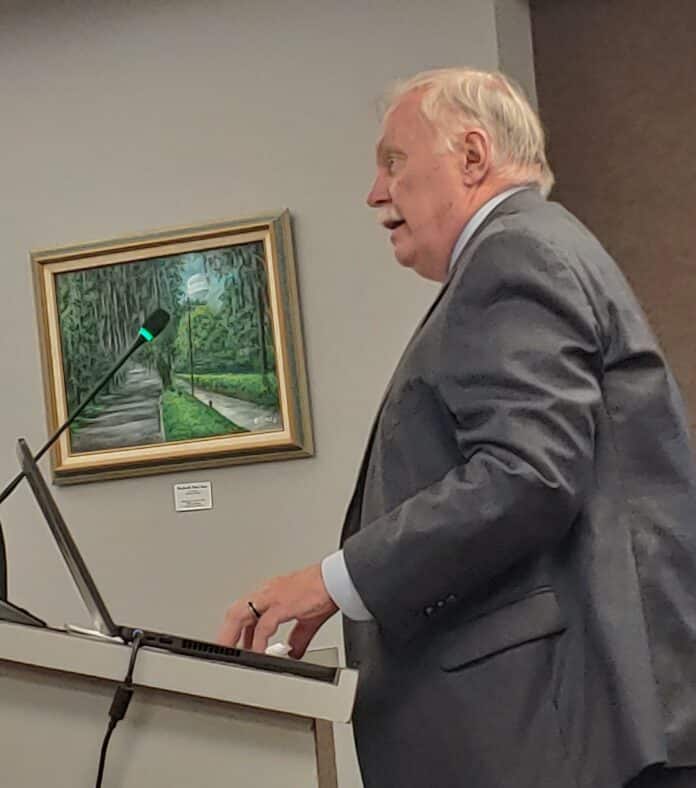The Brooksville City Council directed the City’s Community Development Department to formulate an updated traffic management policy that includes residents’ input about speed limit reductions and the installation of speed humps. In the meantime, the city will notify those in the area that it is contemplating changing the posted speed limit on North Avenue from 25 to 15 miles per hour.
The City’s current traffic management plan was adopted in April 2007.
“Obviously, hasn’t been looked at for a long time (and) the city looks a little different than it did then,” Council Member Christa Tanner said during the panel’s Nov. 6 regular meeting.
During that meeting, members of the council heard Community Development Director David Hainley lay out a plan to update the policy, which would consider the city’s population growth and the subsequent increased traffic in Brooksville’s neighborhoods.
The placement of speed humps or speed tables at appropriate locations is under consideration, but their installation is costly, Hainley said. Speed tables are longer than speed humps that raise a vehicle’s entire wheelbase to reduce speed.
“We have priced out both items,” he said. “They come in somewhere between $4,000 and $5,000 excluding lighting – that’s another $1,000 – $1,500 depending upon the configuration.”
Also, finding a location suitable for the installation of the traffic calming devices can be tricky, Hainley said.
According to Hainley, speed humps should not be installed within 125- feet of either side of an intersection and require that a light be installed where they are located. “On North Avenue, where the light is and where the exclusion area is right on top of the hill – that’s not a good location for a speed hump, either,” he said. “Hale Avenue has a little better chance of getting speed humps located in it – if you choose to do that.”
Flooding
Speed bump location is further frustrated by drainage issues, which have long plagued parts of Brooksville. The soil does not drain well; thus, the water comes down the hills and floods the lower areas.
“We did look at the drainage issues and the culverts. There has been no organized cleaning method, no organized design increasing pipe size as you get down the hill and there is flooding that occurs when there is heavy rain,” Hainley said about the Hale Avenue location.
After that, the condition of the city’s flood-prone areas dominated the conversation.
Vice Mayor David Bailey asked if a timeline had been developed to deal with flooding issues before the city takes on the expense of an engineering report about remedying them. “Do you have a timeline of when the culverts will be cleaned because there are clogs everywhere,” he said. “We were asked to pay for an engineer to tell us what’s wrong with our drainage and I don’t want to spend ( $75,000 of ) the city’s money to tell us what’s wrong when we know it’s an issue – so clean them first (culverts, pipes and swales).
Public Works Director Richard Radacky agreed. Radacky said that pipes, culverts, ditches, and swales in flood-prone areas are filled with dirt and debris, complicating any traffic improvement issues. “There has been zero maintenance done and 80 percent of the city has been neglected for years,” Radacky said. “ It is going to take time, but we’ll get to the bottom of this.”
City Council’s Direction
In the meantime, the council directed Hainley to pursue the development of a new traffic policy and to notify residents in the North Avenue area that the city is contemplating lowering the posted speed limit in that area from 25 miles per hour to 15 miles per hour.
“I do like the citizen input part of it (because) I think we have that obligation as a city,” said Council Member Christa Tanner. “And I’m not opposed to the 15 miles-per-hour (speed limit) only because I feel right now we don’t have the funds to put in $1,000 speed humps whether we wanted them or not.”
Enforcing the new speed limit would probably not be difficult, Mayor Blake Bell said. “A lot of people driving that road are kids from the school and their parents oftentimes pay for their insurance,” “If they get a ticket on that road, their insurance goes up, it’ll wake ‘em up.”
Tanner said that others would be affected, too.
“Obviously (the speed limit change) would (affect) the residents on Sunset and White Way, who would use that road to access 98 or (those using) Howell going to work or on a daily basis,” she said.
The updated traffic policy and the results of the citizen speed limit reduction survey will come before the City Council on Dec. 4.

